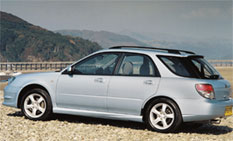Review
We’ve been here before when the ‘bug-eyed’ Impreza was launched in 2000, and again when its slightly less controversial replacement came along in 2003.
Now we’re got the 2006 model year Impreza, available to order now and featuring yet another frontal treatment.
This time it’s ‘hawkeye’ headlamps and the ‘spreadwing’ grille which will become a feature of all new Subarus, and which has already been seen on the forthcoming Tribeca SUV.
It’s becoming a tradition for Subaru to create challenging-looking cars, but it knows it has a loyal customer base and those ‘petrolheads’, as the firm’s UK managing director Peter Kinnaird calls them, don’t seem to mind the looks. After all, Imprezas are all about performance.
And the new range has even more of that. Gone is the old turbocharged 2.0-litre Boxer flat-four engine, replaced by a 2.5-litre unit which powers both the WRX and the ultra-powerful STi.
There’s also a new 2.0-litre engine which powers the entry-level 2.0R models.
But there’s still no diesel, meaning the revised Impreza will have a limited fleet appeal to all but the most performance-orientated user-choosers and perk drivers.
The reason for this omission is that Subaru insists on using Boxer engines, where the cylinders are horizontally-opposed to each other, rather than conventional engines.
This means it can’t borrow an engine from another firm, so it must develop its own diesel. This is happening, says Kinnaird, but their introduction is a long way off. Despite this omission, Subaru is confident it will grow sales next year, helped in the main by the Impreza but also by the recently-revised Legacy and Forester ranges (Fleet NewsNet, October 6).
Kinnaird said: ‘Last year we sold 8,800 cars in the UK and this year will be around 9,250.I’m aiming for 11,000 in 2006, which is entirely possible.
‘We feel the Subaru range should be attracting 12,000-15,000 customers annually and we have the potential to reach 20,000 sales in five years.’
The firm is also aiming to expand its dealer network from 85 to 100 showrooms by the end of the year, and there are plans to add a further 10-15 during 2006. One of these will be a flagship site in London, and the cost of this means Subaru won’t be represented at next year’s British Motor Show.

But there is some good news for company car drivers who really want an Impreza on their drive. The new 2.0R models, available in both saloon and five-door form, offer some of the WRX’s sporty nature in a more realistic package.
With 158bhp, the 2.0R offers four-wheel drive and some of that charismatic flat four engine burble in a package starting at £16,200.
The emissions and fuel economy are markedly improved over the WRX, too, so company car tax bills won’t be as high either.
According to Subaru, it has the essential DNA to link it to its World Rally Championship (WRC) exploits.
But this highlights a dichotomy in Subaru’s plans. Its most high-profile coverage comes from the WRC, where star driver Petter Solberg finished runner-up this season, but the firm wants to move away from this predominantly petrolhead image.
Kinnaird wants the UK divison to focus on selling models other than the sporty Imprezas. He added: ‘Our activities will be focused on selling other Imprezas from the new range rather than just the WRC lookalikes.
‘We are moving towards becoming a premium brand without premium prices.’
Behind the wheel
THERE is a marked difference in performance between last year’s Impreza and this version.
The new 2.5-litre engine in the WRX and STi plays a major part in this, offering more torque much lower down in the rev range. Pressing the throttle at low revs gives an instant response, with the Impreza accelerating with much more vigour than before.

Once the engine is up and running, it’s harder to tell them apart, as both models accelerate hard and fast, just like the old 2.0-litre turbo versions.
In WRX form, the Impreza offers 227bhp, which is enough for 0-62mph acceleration in just 5.4 seconds. Thanks to its improved mid-range, it doesn’t feel that far short of the STi’s 276bhp when accelerating in lower gears.
But once you get into higher gears the STi’s extra urge makes itself known, with the ability to keep building speed at a very quick rate.
And thankfully that flat-four burble has been retained, giving the Impreza more character than its main rival, Mitsubishi’s Lancer Evo IX.
As well as more power, Subaru has been busy working on other changes, such as an electronic throttle for more responsiveness and a new family of gearboxes (five-speed for the 2.0R and WRX and six for the STi).
While the WRX and STi will grab the headlines, the lesser 2.0R springs a surprise. It may only have 158bhp but it offers that bubbly engine note and respectable performance.
And, as it shares a four-wheel drive set-up with the rest of the range, handling is surefooted and there is plenty of grip.
Driving verdict
BOTH the WRX and STi models benefit from a useful dollop of extra mid-range power, while the new gearboxes give even slicker shifts than before. The WRX is a very quick car, while the STi is seriously rapid. But don’t overlook the unassuming 2.0R – it’s better than the on-paper figures suggest.


| Model: | 2.0R | 2.5 WRX | 2.5 WRX STi | |||
| Max power (bhp/rpm): | 158/6,400 | 227/5,600 | 276/6,000 | |||
| Max torque (lb-ft/rpm): | 137/3,200 | 236/3,600 | 289/4,000 | |||
| Max speed (mph): | 130 | 143 | 158 | |||
| 0-62mph (secs): | 8.5 | 5.4 | 5.0 | |||
| Fuel consumption (mpg): | 31.4 | 27.4 | 25.9 | |||
| CO2 emissions (g/km): | 214 | 244 | 257 | |||
| Prices (OTR): | £16,200–£26,995 | |||||
















